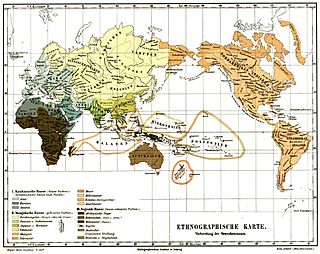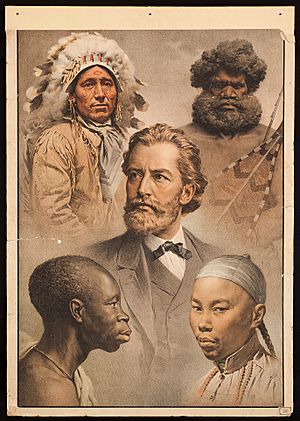Historical definitions of race facts for kids
Some scientists once believed that humans could be divided into different "races" based on how they looked. For example, they spoke of the Caucasian race (living in Europe, North Africa, and West Asia), the Mongoloid race (living in East Asia, Australia, and the Americas), and the Negroid race (living in Africa south of the Sahara). Other scientists had slightly different ideas, suggesting four or five races. These ideas were popular from the late 1700s to the mid-1900s. Because these ideas are from the past, they are called historical definitions of race or historical race concepts.
Today, scientists agree that there is only one human race. Modern genetic research has clearly shown that the old idea of three, four, or five separate races was wrong.
Old Ideas About Human Races

| Caucasoid: Aryans Semitic Hamitic Negroid: African Negro Khoikhoi Melanesian Negrito Australoid Uncertain: Dravida & Sinhalese |
Mongoloid: North Mongol Chinese & Indochinese Korean & Japanese Tibetan & Burmese Malay Polynesian Maori Micronesian Eskimo & Inuit American |
In the past, people tried to classify humans into different groups. One famous classification was by Johann Friedrich Blumenbach in 1779. He suggested five main groups:
- The Ethiopian or black race.
- The Caucasian race or white race.
- The Mongolian or yellow race.
- The American or red race.
- The Malayan or brown race.
Later, in the mid-1900s, an American anthropologist named Carleton S. Coon also divided humanity into five races:
- Negroid (Black) race.
- Australoid (Australian Aboriginal and Papuan) race.
- Capoid (Bushmen/Hottentots) race.
- Mongoloid (Oriental/Amerindian) race.
- Caucasoid (White) race.
These classifications were based on physical appearance, not on scientific understanding of human genetics.
What is Racism?
The old ideas about human races led to a lot of prejudice. People from different groups often thought they were better than others. This belief is called Racism. Racism is a harmful idea that says one particular "race" is naturally superior (better) or inferior (worse) than others. It claims there are deep, biological differences between groups of people. Racism also suggests that different "races" should live separately and not marry each other. Someone who supports racism is called a racist.
These racist attitudes caused terrible events in history. They supported the horrors of African slavery, the unfair system of Apartheid in South Africa, the Jim Crow laws in the United States, the cruelty of Nazism in Germany, and Japanese imperialism. All these events caused great suffering because people believed one group was better than another.
Images for kids
-
Blumenbach's five races
See also
 In Spanish: Historia del concepto de raza para niños
In Spanish: Historia del concepto de raza para niños






